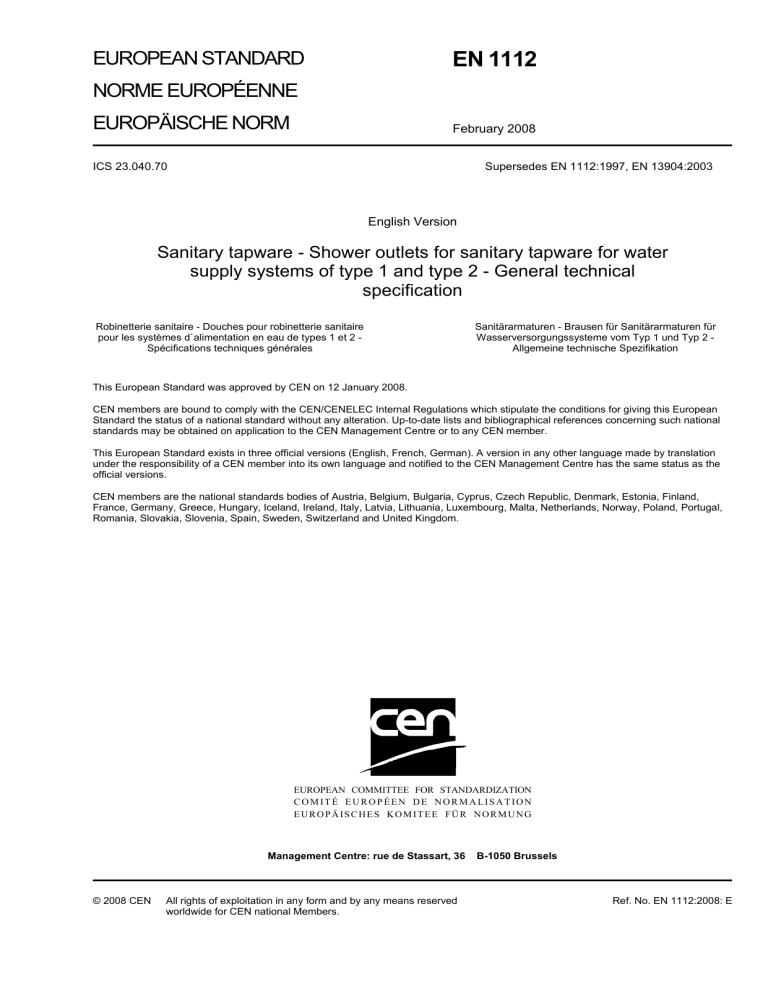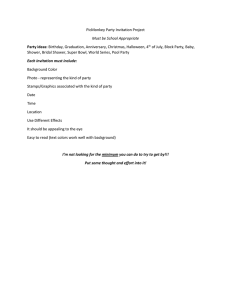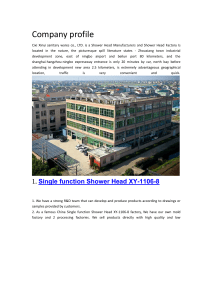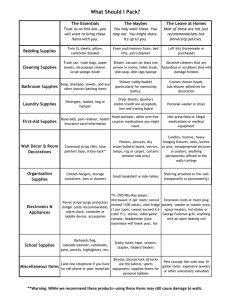
EUROPEAN STANDARD EN 1112 NORME EUROPÉENNE EUROPÄISCHE NORM February 2008 ICS 23.040.70 Supersedes EN 1112:1997, EN 13904:2003 English Version Sanitary tapware - Shower outlets for sanitary tapware for water supply systems of type 1 and type 2 - General technical specification Robinetterie sanitaire - Douches pour robinetterie sanitaire pour les systèmes d`alimentation en eau de types 1 et 2 Spécifications techniques générales Sanitärarmaturen - Brausen für Sanitärarmaturen für Wasserversorgungssysteme vom Typ 1 und Typ 2 Allgemeine technische Spezifikation This European Standard was approved by CEN on 12 January 2008. CEN members are bound to comply with the CEN/CENELEC Internal Regulations which stipulate the conditions for giving this European Standard the status of a national standard without any alteration. Up-to-date lists and bibliographical references concerning such national standards may be obtained on application to the CEN Management Centre or to any CEN member. This European Standard exists in three official versions (English, French, German). A version in any other language made by translation under the responsibility of a CEN member into its own language and notified to the CEN Management Centre has the same status as the official versions. CEN members are the national standards bodies of Austria, Belgium, Bulgaria, Cyprus, Czech Republic, Denmark, Estonia, Finland, France, Germany, Greece, Hungary, Iceland, Ireland, Italy, Latvia, Lithuania, Luxembourg, Malta, Netherlands, Norway, Poland, Portugal, Romania, Slovakia, Slovenia, Spain, Sweden, Switzerland and United Kingdom. EUROPEAN COMMITTEE FOR STANDARDIZATION COMITÉ EUROPÉEN DE NORMALISATION EUROPÄISCHES KOMITEE FÜR NORMUNG Management Centre: rue de Stassart, 36 © 2008 CEN All rights of exploitation in any form and by any means reserved worldwide for CEN national Members. B-1050 Brussels Ref. No. EN 1112:2008: E EN 1112:2008 (E) Contents Page Foreword..............................................................................................................................................................4 Introduction .........................................................................................................................................................5 1 Scope ......................................................................................................................................................6 2 Normative references ............................................................................................................................9 3 Terms and definitions ...........................................................................................................................9 4 Classification..........................................................................................................................................9 5 Designation ..........................................................................................................................................10 6 Marking .................................................................................................................................................10 7 7.1 7.2 Materials ...............................................................................................................................................10 Chemical and hygienic requirements ................................................................................................10 Exposed surface condition and quality of coating ..........................................................................10 8 8.1 8.2 8.3 Dimensional Characteristics ..............................................................................................................10 General..................................................................................................................................................10 Connecting Dimensions......................................................................................................................11 Special Cases.......................................................................................................................................12 9 9.1 9.2 9.2.1 9.2.2 9.2.3 9.2.4 Leaktightness Characteristics............................................................................................................13 General..................................................................................................................................................13 Test Method..........................................................................................................................................13 Principle................................................................................................................................................13 Apparatus .............................................................................................................................................13 Procedure .............................................................................................................................................13 Requirements .......................................................................................................................................13 10 10.1 10.2 10.2.1 10.2.2 10.2.3 10.2.4 10.2.5 10.3 10.3.1 10.3.2 10.3.3 10.3.4 10.3.5 Mechanical Characteristics ................................................................................................................13 General..................................................................................................................................................13 Mechanical Strength............................................................................................................................14 Test Method..........................................................................................................................................14 Principle................................................................................................................................................14 Apparatus .............................................................................................................................................14 Procedure .............................................................................................................................................14 Requirements .......................................................................................................................................14 Thermal Shock Test.............................................................................................................................15 General..................................................................................................................................................15 Principle................................................................................................................................................15 Apparatus .............................................................................................................................................15 Procedure .............................................................................................................................................16 Requirements .......................................................................................................................................17 11 11.1 11.2 11.2.1 11.2.2 11.2.3 11.2.4 11.2.5 Hydraulic Characteristics ...................................................................................................................17 General..................................................................................................................................................17 Flow rate ...............................................................................................................................................17 Test Method..........................................................................................................................................17 Principle................................................................................................................................................17 Apparatus .............................................................................................................................................17 Procedure .............................................................................................................................................19 Requirement .........................................................................................................................................19 12 Acoustic characteristics .....................................................................................................................20 2 EN 1112:2008 (E) 12.1 12.2 12.3 12.4 General .................................................................................................................................................20 Procedure .............................................................................................................................................20 Expression of results ..........................................................................................................................20 Determination of acoustic group .......................................................................................................20 13 Maintenance.........................................................................................................................................20 14 14.1 14.2 14.2.1 14.2.2 14.2.3 14.2.4 Rotary connection ...............................................................................................................................20 General .................................................................................................................................................20 Test method .........................................................................................................................................21 Principle................................................................................................................................................21 Apparatus .............................................................................................................................................21 Procedure .............................................................................................................................................21 Requirements.......................................................................................................................................21 3 EN 1112:2008 (E) Foreword This document (EN 1112:2008) has been prepared by Technical Committee CEN/TC 164 “Water supply”, the secretariat of which is held by AFNOR. This European Standard shall be given the status of a national standard, either by publication of an identical text or by endorsement, at the latest by August 2008, and conflicting national standards shall be withdrawn at the latest by August 2008. Attention is drawn to the possibility that some of the elements of this document may be the subject of patent rights. CEN [and/or CENELEC] shall not be held responsible for identifying any or all such patent rights. This document supersedes EN 1112:1997 and EN 13904:2003 The scope is enlarged to include requirements for shower outlets used with water supply systems of type 1 and type 2. See Tables 1, 3, 4, 5 and 7. According to the CEN/CENELEC Internal Regulations, the national standards organizations of the following countries are bound to implement this European Standard: Austria, Belgium, Bulgaria, Cyprus, Czech Republic, Denmark, Estonia, Finland, France, Germany, Greece, Hungary, Iceland, Ireland, Italy, Latvia, Lithuania, Luxembourg, Malta, Netherlands, Norway, Poland, Portugal, Romania, Slovakia, Slovenia, Spain, Sweden, Switzerland and the United Kingdom. 4 EN 1112:2008 (E) Introduction In respect of potential adverse effects on the quality of water intended for human consumption, caused by the product covered by this standard: this standard provides no information as to whether the product may be used without restriction in any of the Member States of the EU or EFTA; it should be noted that while awaiting the adoption of verifiable European criteria, existing national regulations concerning the use and/or the characteristics of these products remain in force. --`,`,`,,,`,`,`,,,,,,,,,,,``,,``-`-`,,`,,`,`,,`--- 5 EN 1112:2008 (E) 1 Scope This European Standard specifies: the dimensional, leaktightness, mechanical, hydraulic and acoustic characteristics with which shower outlets shall comply; the procedures for testing these characteristics. This European Standard applies to shower heads and hand showers of any material used for ablutionary purposes and intended for equipping and supplementing sanitary tapware for baths and showers. This European Standard applies to shower heads and hand showers connected downstream of the obturator of the tapware. Integral and remote spray attachments incorporated in tapware (e.g. sink and wash basin mixing valves) are not covered by this standard. Details of pressures and temperatures are given in Table 1. Table 1 — Conditions of use/Classifications --`,`,`,,,`,`,`,,,,,,,,,,,``,,``-`-`,,`,,`,`,,`--- Water Supply system Flow rate classes Operating range of shower outlets Limits Dynamic Pressure Recommended Dynamic Pressure ZZ (0,025 ≤ Q < 0,12) l/s (1,5 ≤ Q < 7,2) l/min Z (0,12 ≤ Q < 0,20) l/s (7,2 ≤ Q < 12) l/min A (0,20 ≤ Q < 0,25) l/s (12 ≤ Q < 15) l/min S (0,25 ≤ Q < 0,33) l/s (15 ≤ Q < 20) l/min B (0,33 ≤ Q < 0,42) l/s (20 ≤ Q < 25) l/min C (0,42 ≤ Q < 0,50) l/s (25 ≤ Q < 30) l/min D (0,50 ≤ Q < 0,63) l/s (30 ≤ Q < 38) l/min E (0,06 ≤ Q < 0,14) l/s (3,6 ≤ Q < 8,4) l/min (0,1 to 0,3) MPa (0,05 to 0,5) MPa (1,0 to 3) bar (0,5 to 5) bar Type 1 see Figure 1 Dynamic Pressure Dynamic Pressure Type 2 see Figure 2 (0,01 to 0,2) MPa (0,02 to 0,1) MPa (0,1 to 2) bar (0,2 to 1) bar Temperature T < 70°C T < 42°C 6 Acoustics Marking See clause 12.0 See clause 6.0 Group I Group II at (0,01) MPa (0,1 bar) (unclassified) H (Q ≥ 0,14) l/s (Q ≥ 8,4) l/min at (0,01) MPa (0,1 bar) for example IA II B EN 1112:2008 (E) Key 1 Cold water 2 3 Hot Water Mains supply pipe (Supply pressures up to 10 bar) 4 Water heater Figure 1 — Type 1 Water supply system with a pressure range of (0,05 - 1,0)MPa (0,5 - 10)bar 7 EN 1112:2008 (E) Key 1 2 Cold water storage cistern (cover omitted for clarity) Warning pipe 3 4 Vent pipe Hot water cylinder 5 6 Alternative cistern fed cold supply to sanitary appliances To boiler 7 Mains supply pipe (Supply pressures up to 10 bar) Figure 2 — Type 2 Water supply system with a pressure range of (0,01 - 1,0) MPa, (0,1 - 10) bar. A vented domestic hot water and cold water supply system incorporating gravity hot water, mains cold water and alternative gravity cold water supply to sanitary appliances 8 EN 1112:2008 (E) 2 Normative references The following referenced documents are indispensable for the application of this document. For dated references, only the edition cited applies. For undated references, the latest edition of the referenced document (including any amendments) applies. EN 248, Sanitary tapware – General specification for electrodeposited coatings of Ni-Cr EN 1113, Sanitary tapware - Shower hoses for sanitary tapware for supply systems type 1 and type 2 – General technical specification EN ISO 228-1, Pipe threads where pressure-tight joints are not made on the threads – Part 1: Dimensions, tolerances and designation (ISO 228-1:2000) EN ISO 3822-1, Acoustics – Laboratory tests on noise emission from appliances and equipment used in water supply installations - Part 1: Method of measurement (ISO 3822-1:1999) EN ISO 3822-4, Acoustics – Laboratory tests on noise emission from appliances and equipment used in water supply installations - Part 4: Mounting and operating conditions for special appliances (ISO 3822-4:1985) 3 Terms and definitions For the purposes of this document, the following terms and definitions apply. 3.1 shower outlet device for ablutionary purposes which allows water to be emitted in the form of jets or water droplets 3.2 spray plate device with orifices through which water passes and forms a spray of water with separate, definable jets or water droplets 3.3 shower arm component which supports a shower head and connects it to the water supply 4 Classification Shower handsets. Shower handsets are moveable hand held shower outlets which are connected to the sanitary tapware via a shower hose, complying with EN 1113. They can be hung directly on the tapware or on the wall with the aid of an appropriate support. Shower heads and Body showers. Shower heads are fixed overhead shower outlets which direct water onto the user from above. Body showers are shower outlets fixed to a vertical wall and direct water laterally onto the user. 9 EN 1112:2008 (E) 5 Designation Shower outlets covered by this standard are designated by: their classification (see clause 4); reference to this European Standard: EN 1112; their connecting thread dimension; their flow rate class (see Table 1); their acoustic group (where applicable). Examples: shower handset, EN 1112, flow rate class H; NOTE For shower handsets the connecting thread size need not be given, as it is always G 1/2. shower head, EN 1112, G 1/2 flow rate class E. 6 Marking Shower outlets complying with this standard shall be marked permanently and legibly with the manufacturer's mark or the supplier's mark. The least favourable acoustic group (where applicable) and the highest flow rate class must appear on the product but it need not be permanent. 7 Materials 7.1 Chemical and hygienic requirements All materials coming into contact with water intended for human consumption shall present no risk to health at temperatures up to the maximum working temperature. They shall not cause any change to drinking water in terms of quality, appearance, smell or taste. Within the recommended limit for correct operation (see Table 1), the materials shall not undergo any change which would impair the performance of shower outlets. 7.2 Exposed surface condition and quality of coating Visible chromium plated surfaces and Ni-Cr coatings shall comply with the requirements of EN 248. 8 Dimensional Characteristics 8.1 General --`,`,`,,,`,`,`,,,,,,,,,,,``,,``-`-`,,`,,`,`,,`--- The design and construction of components without defined dimensions permits various design solutions to be adopted by the manufacturer. Permitted deviations from defined dimensions are specified in clause 8.3. 10 EN 1112:2008 (E) 8.2 Connecting Dimensions The connecting dimensions of shower outlets are specified in Table 2 and Figures 3 to 7. Figure 3a — Shower head Figure 3b — Shower head (detail) Figure 4 — Shower arm or shower head Figure 5 — Shower head and body showers --`,`,`,,,`,`,`,,,,,,,,,,,``,,``-`-`,,`,,`,`,,`--- Figure 6a — Shower arm Figure 6b — Shower arm (detail) 11 EN 1112:2008 (E) st Figure 7b — Shower handset – 1 type of thread Figure 7a — Shower handset Figure 7c — Shower handset – 2 of thread nd type Table 2 — Connecting dimensions Dimension Values Comments A G1/2B EN ISO 228-1 B ≥ 7,5 mm B’ ≥ 9,5 mm C ≥ 5 mm Recommended for wall installation Adjustability of the escutcheon D ≥ 50 mm Recommended for wall installation E ≥ 15 mm Recommended for wall installation Distance between end of thread and face of escutcheon. It is not the length of the thread. F G 1/2 or EN ISO 228-1 G 3/4 G 8,5 + 0/-1 mm Functional dimension on seal depth H G 1/2 B or EN ISO 228-1 G 3/4 B A ≤ 3,6 mm 8.3 Special Cases Shower outlets intended for special applications e.g., when dimensional interchange ability is not a requirement, can incorporate dimensional deviations provided: 12 connection to the installation is guaranteed; EN 1112:2008 (E) threaded connections are in compliance with ISO standards; all other requirements of this standard are satisfied; the manufacturer’s literature, including the installation instructions supplied with the shower outlet indicates clearly that the shower outlet is a special case. 9 Leaktightness Characteristics 9.1 General The test described is a type test (laboratory test) and not a quality control test carried out during manufacture. 9.2 Test Method 9.2.1 Principle The test is based on the principle of checking the leaktightness of the shower outlet with positive internal water pressure. 9.2.2 Apparatus A suitable test circuit (see figure 10) capable of providing and maintaining the required pressure and flow rate for the duration of the test. 9.2.3 Procedure Connect the shower outlet as supplied to the test circuit. With water flowing at a temperature ≤ 30 °C, apply the appropriate test pressure specified in Table 3 and maintain for (300 ± 10) s. In the case of multifunction and varifunction shower outlets the test shall be carried out for each function. Table 3 — Pressure conditions for leaktightness test Shower outlet for installations of Type 1 (0,5 ± 0,02) MPa (5 ± 0,2) bar Shower outlet for installations of Type 2 (0,2 ± 0,01) MPa (2 ± 0,1) bar 9.2.4 Requirements For the duration of the test there shall be no leakage between the connecting point and body, or at the connection between the spray plate and body. 10 Mechanical Characteristics 10.1 General The tests described are type tests (laboratory tests) and not quality control tests carried out during manufacture. 13 EN 1112:2008 (E) 10.2 Mechanical Strength 10.2.1 Test Method This clause defines a test method to establish the mechanical strength of shower handsets. 10.2.2 Principle A force F is applied to the shower handset as shown in Figures 8 or 9. 10.2.3 Apparatus A device into which the shower handset connecting thread can be screwed and a means for applying a force to the shower handset. 10.2.4 Procedure Attach the shower handset to the fixing device by its connecting thread so that there is no play. Apply a force F as shown in Figures 8 or 9 for a duration of (300 ± 10) s. Hinged joints with a stop are to be tested as shown in Figure 9, positioned at the stop. 10.2.5 Requirements After the test there shall be no cracking or permanent visible deformation. F = (60 ± 2) N; L = (50 ± 5) mm Figure 8 — Handset with rigid connection 14 EN 1112:2008 (E) F = (60 ± 2) N; L = (50 ± 5) mm Figure 9 — Handset with hinged joint 10.3 Thermal Shock Test 10.3.1 General This test simulates use under conditions of extreme temperatures and establishes the integrity of the complete product. 10.3.2 Principle The principle consists of subjecting the shower outlet to cycles of hot and cold water at a temperature equal to the limits of use. 10.3.3 Apparatus The test apparatus is detailed in Figure 10. 15 EN 1112:2008 (E) Key a) b) (8) supply circuit: 1) means for supplying and maintaining hot water temperature and pressure for the duration of the test; 2) means for supplying and maintaining cold water temperature and pressure for the duration of the test; 3) means for alternating from hot to cold water and vice versa within 2 s; 4) means for measuring pressure with an accuracy of ± 1 %; 5) means for measuring temperature with an accuracy of ± 1 °K. (9) test circuit: 6) connection; 7) test sample. Figure 10 — Apparatus for thermal shock test The supply circuit shall be capable of providing the maximum recommended dynamic pressure, specified in Table 1, with hot water at (70 ± 2) °C and cold water at (20 ± 2) °C. 10.3.4 Procedure Connect the shower outlet to the test circuit and subject it to cycles of (120 ± 10) s of cold water and then (120 ± 10) s of hot water with flow rates between 0,08 l/s and 0,12 l/s, but not exceeding the pressures specified in Table 4: 16 EN 1112:2008 (E) Table 4 — Pressure conditions for thermal shock test Supply system Pressure Type 1 (0,3 ± 0,02) MPa (3 ± 0,2) bar Type 2 (0,1 ± 0,01) MPa (1,0 ± 0,1) bar Repeat this cycle continuously 300 times. 10.3.5 Requirements During and after this test there shall be no visible leakage, cracking, permanent deformation or deterioration in function. The shower outlet shall satisfy the requirements for leaktightness (clause 9). 11 Hydraulic Characteristics 11.1 General The test described is a type test (laboratory test) and not a quality control test carried out during manufacture. 11.2 Flow rate 11.2.1 Test Method 11.2.2 Principle The principle consists of a method for measuring the flow rate through the shower outlet using cold water (T ≤ 30 °C) in order to determine the flow rate class (see Table 1). 11.2.3 Apparatus The test apparatus is detailed in Figure 11. 17 EN 1112:2008 (E) Figure 11a Figure 11b — (detail key 7) Key a) b) (10) supply circuit comprising: 1) device for measuring the flow rate with an accuracy of ± 2 %; 2) means for measuring and maintaining the required pressure with an accuracy of ± 1 %. (11) test circuit comprising: 3) DN15 regulating valve; 4) straight DN15 pipe; 5) pressure take off tee (Figure 12); 6) pressure measuring device to measure the appropriate pressure specified in Table 5 with an accuracy of ± 1 %; 7) adapter to connect the inlets of the various shower outlets shown in Figures 3 to 7 (see Figure 11b) enabling orientation of the spray to be in a downwards direction; 8) datum; 9) test pressure. Figure 11 – Apparatus for hydraulic characteristics The supply and test circuits shall be capable of delivering the appropriate pressure specified in Table 1, when the shower outlet under test is installed. 18 EN 1112:2008 (E) --`,`,`,,,`,`,`,,,,,,,,,,,``,,``-`-`,,`,,`,`,,`--- Figure 12 — Pressure take-off tee (unspecified tolerances ± 0,5) 11.2.4 Procedure Connect the shower outlet to the supply and test circuits using adapter (Figure 11, Key 7). Rotate the adapter around its horizontal axis until the spray plate or spray forming mechanism is in a horizontal position with a vertically downwards discharge. Apply the appropriate pressure specified in Table 5 using the centre of the spray plate or spray forming mechanism as a datum. Record the flow rate “Q” after stabilisation. Observe the spray formation. Table 5 — Pressure conditions for flow rate test Supply system Pressure Type 1 (0,3 + 0,02) MPa (3 + 0,2) bar Type 2 (0,01 + 0,005) MPa (0,1 + 0,05) bar 11.2.5 Requirement Shower outlets shall be classified according to the flow rate value “Q” specified in Table 1 with water supplied at the appropriate pressure specified in Table 5 provided the spray formation under these conditions is observed to be fully formed. For multi-functional or vari-functional shower outlets the maximum flow rate shall determine the flow rate class. 19 EN 1112:2008 (E) For multi-functional shower outlets the manufacturer shall indicate in product literature the minimum pressure required for each function. 12 Acoustic characteristics 12.1 General This clause specifies the method of classifying shower outlets by acoustic group and flow classes where appropriate. 12.2 Procedure The method of measurement shall be in accordance with EN ISO 3822-1, using the procedure specified in EN ISO 3822-4. Shower outlets are tested as supplied and the flow rate obtained at the test pressure of (0,3 ± 0,02) MPa (3,0 ± 0,2) bar is reported. 12.3 Expression of results The results of the measurements taken in accordance with EN ISO 3822-1 and EN ISO 3822-4 are expressed by the noise emission of the shower outlet Lap, in dB(A). 12.4 Determination of acoustic group The acoustic group is determined by the value of Lap obtained at a flow pressure of (0,3) MPa (3) bar and is classified in acoustic group I, II or U as shown in Table 6. Table 6 — Acoustic group Group Lap in dB(A) I < 20 II 20 < Lap < 30 U ( not classified ) > 30 13 Maintenance The spray plate for needle (normal) jets shall be removable by the use of simple tools, or by special tools supplied by the manufacturer for cleaning purposes. Shower outlets with an integrated cleaning device for the needle (normal) jets need not have this facility. 14 Rotary connection 14.1 General The test described is a type test (laboratory test) and not a quality control test carried out during manufacture. If a shower handset has a rotary connection permitting the handle to turn freely relative to the shower hose, this connection shall be capable of functioning correctly and shall prevent twisting of the shower hose. 20 EN 1112:2008 (E) 14.2 Test method 14.2.1 Principle The test is intended to check the function of any rotary connection. 14.2.2 Apparatus Key 1. water supply capable of supplying and maintaining the appropriate test pressure specified in Table 7; 2. rigid supply pipe for holding the shower handset at the connection thread so that the shower hangs down vertically; 3. device which engages with the shower handset in order to enable measurement of the initial torque necessary to rotate the shower handset relative to the rotary connection. Figure 13 — Rotary connection test apparatus 14.2.3 Procedure Seal the spray forming device so that it is watertight. Connect the rotary connection of the shower handset to the supply pipe. Apply cold water ≤ 30 °C at the appropriate pressure specified in Table 7. Table 7 — Pressure conditions for rotary connection test Supply system Pressure Type 1 (0,3 ± 0,02) MPa (3 ± 0,2) bar Type 2 (0,1 ± 0,01) MPa (1,0 ± 0,1) bar Measure the torque necessary to initiate rotation of the shower handset relative to the rotary connection. 14.2.4 Requirements The initial torque shall not exceed 0,1 Nm. 21




